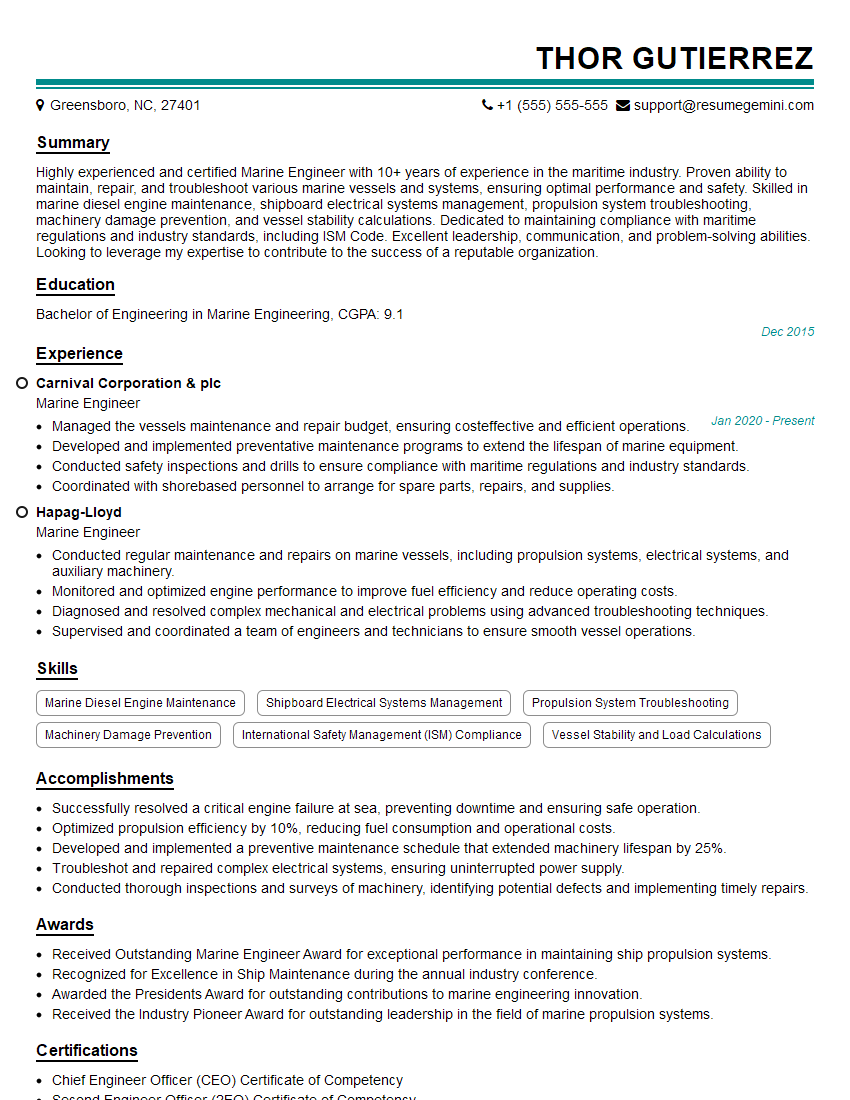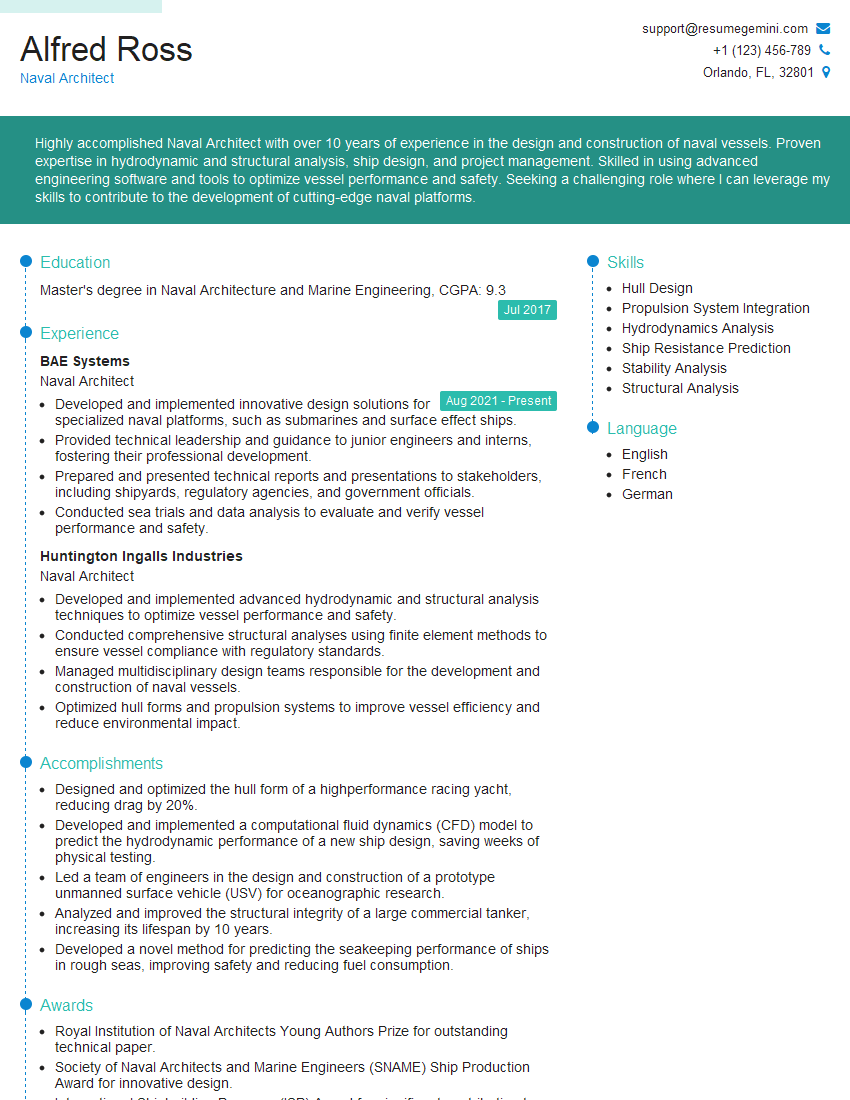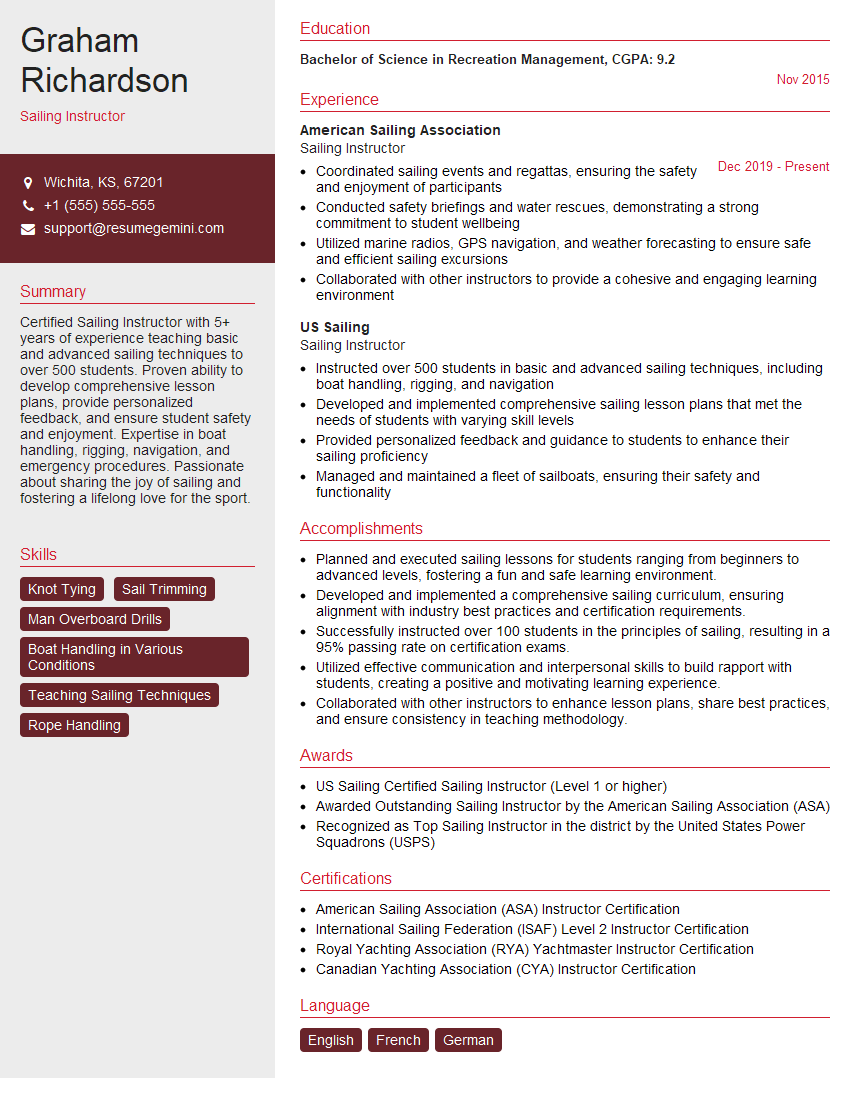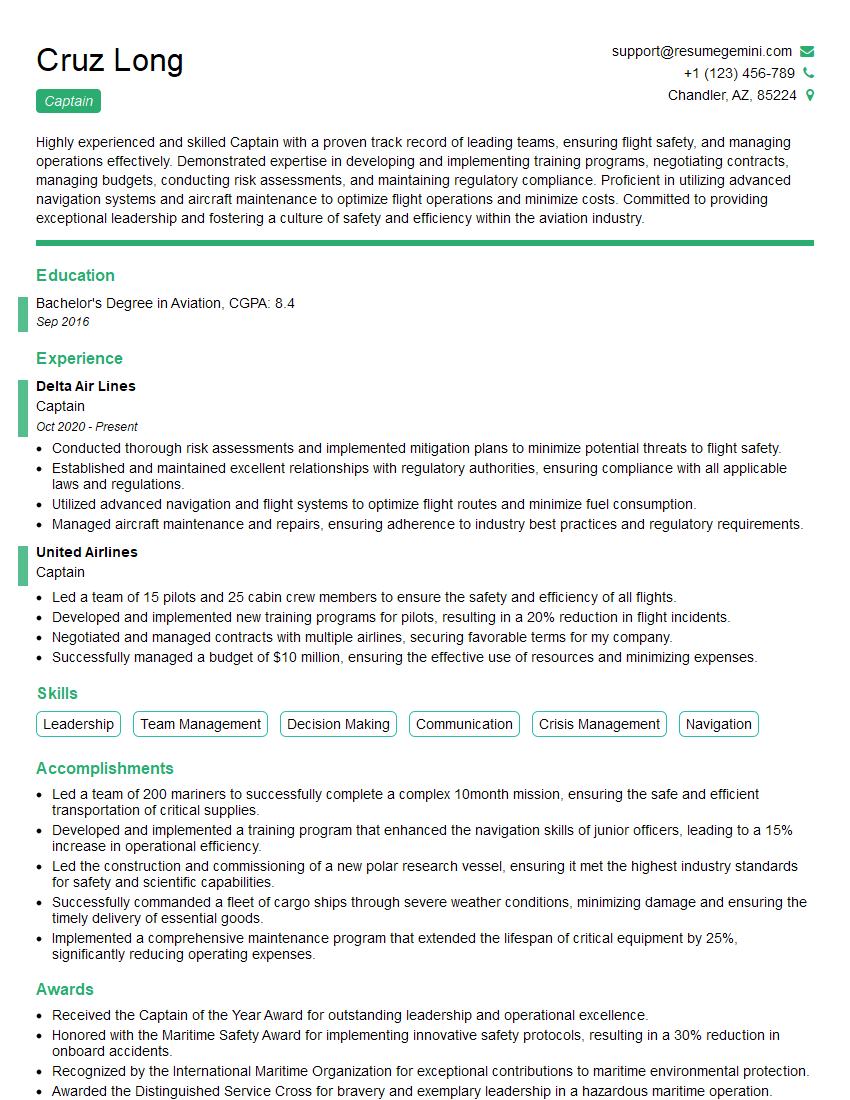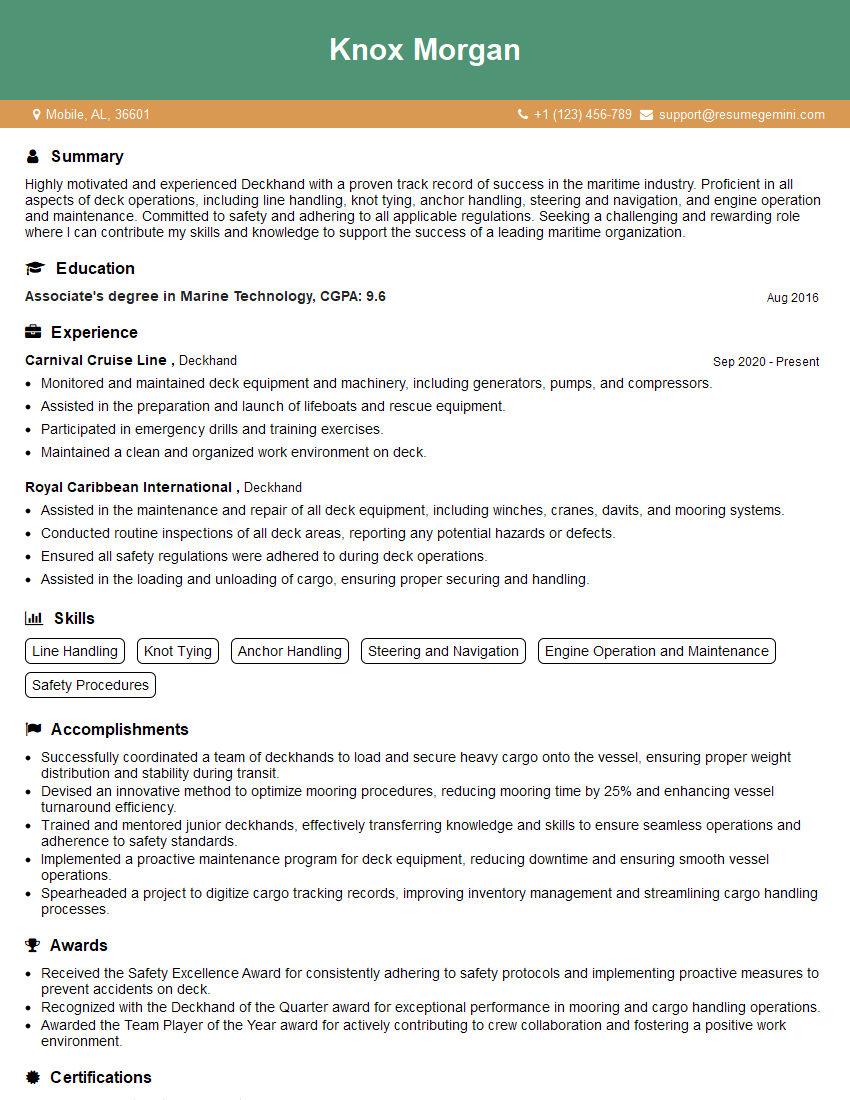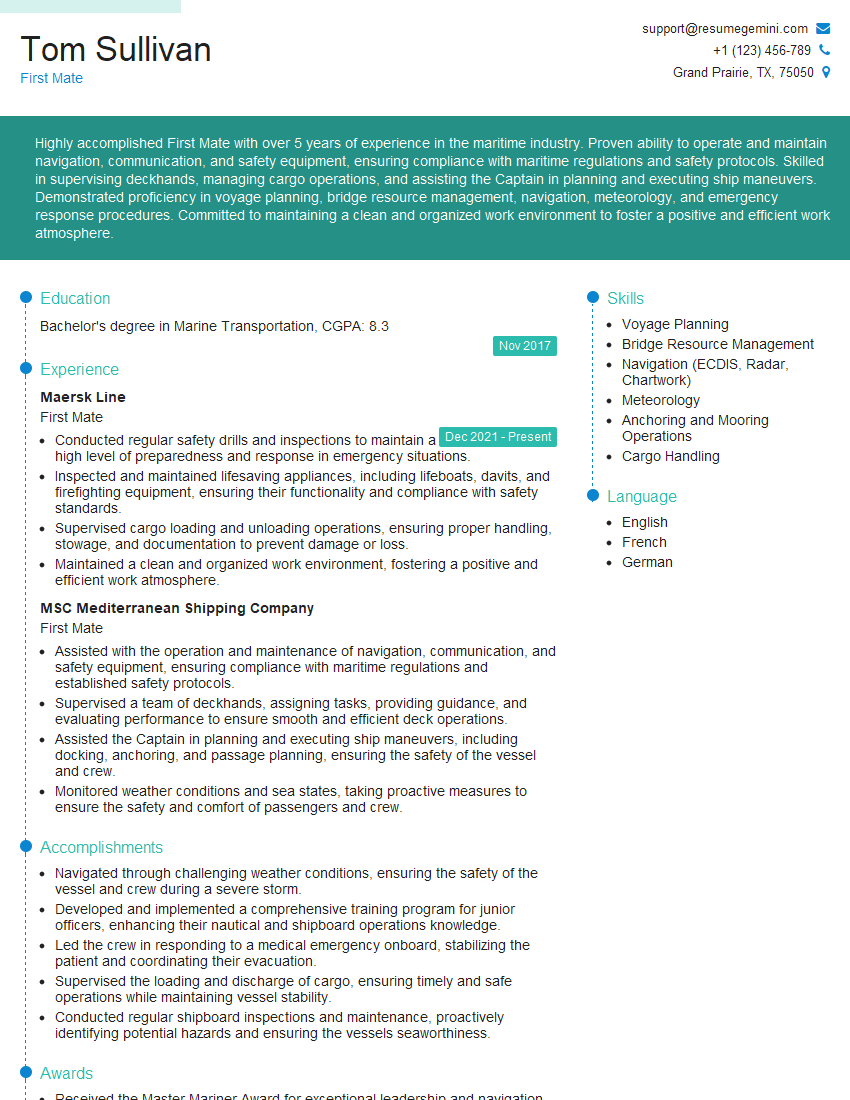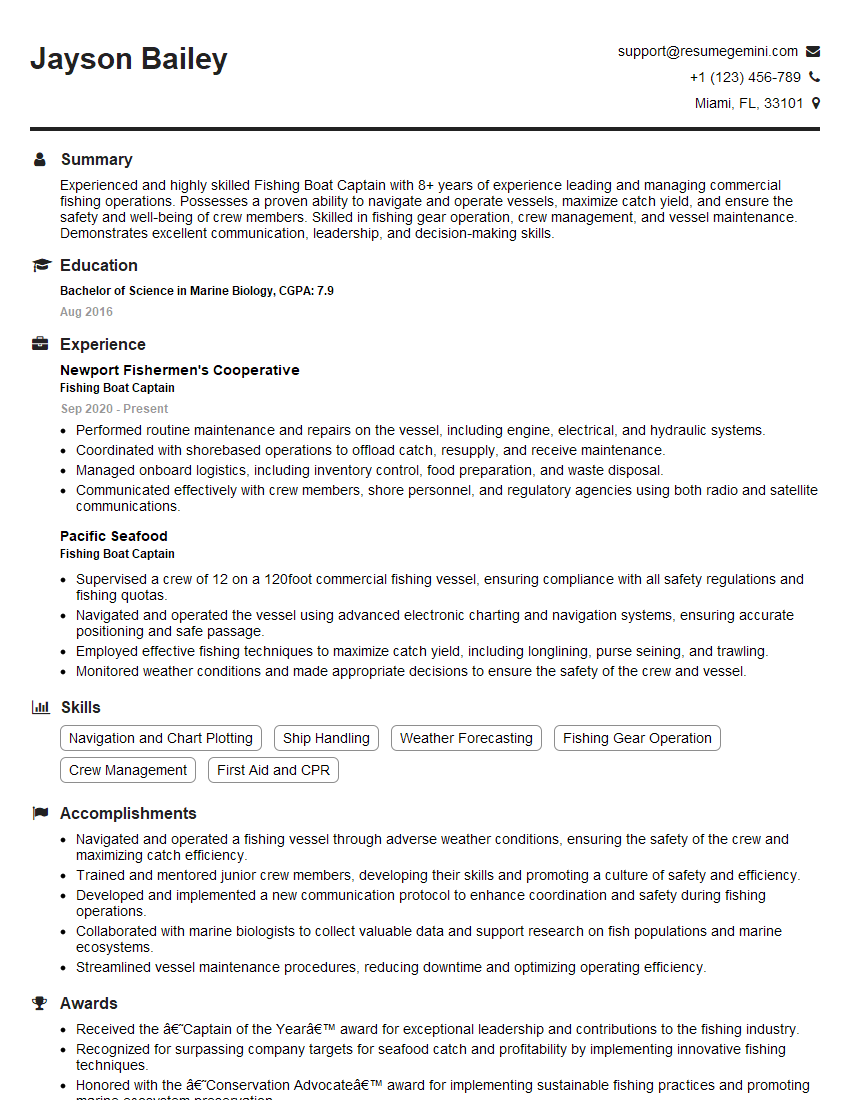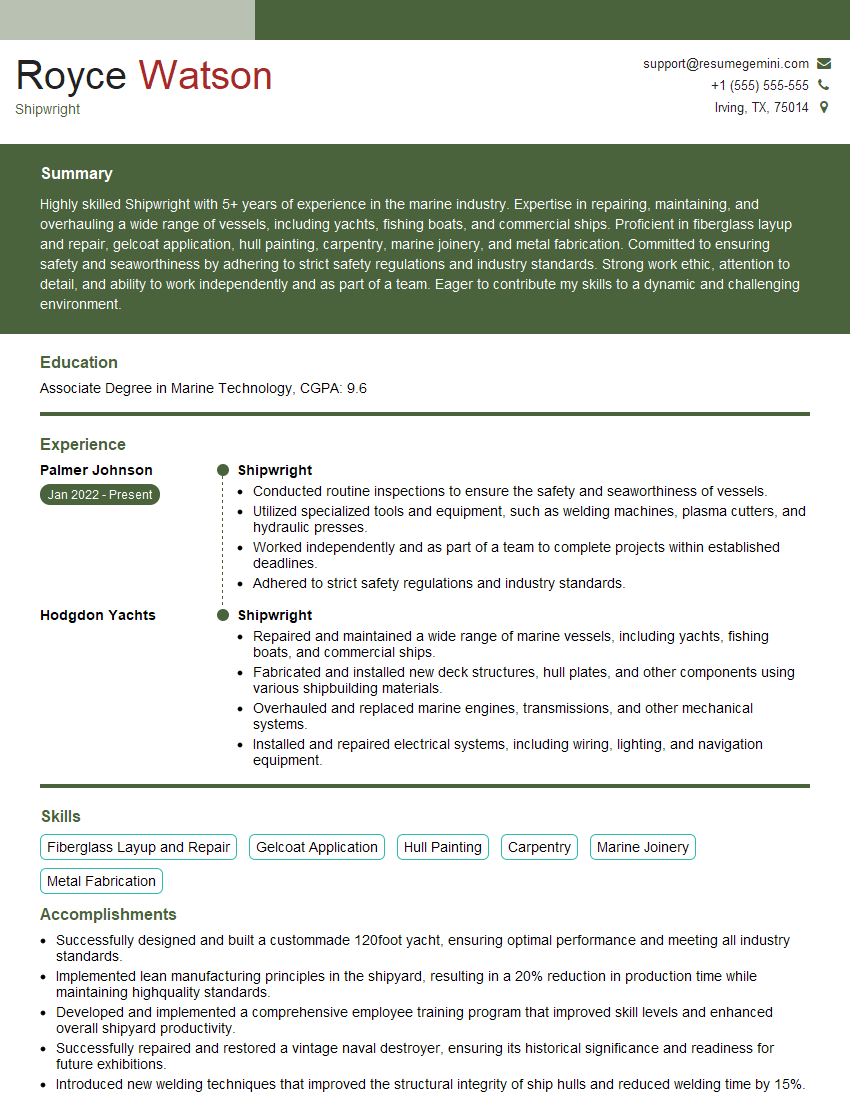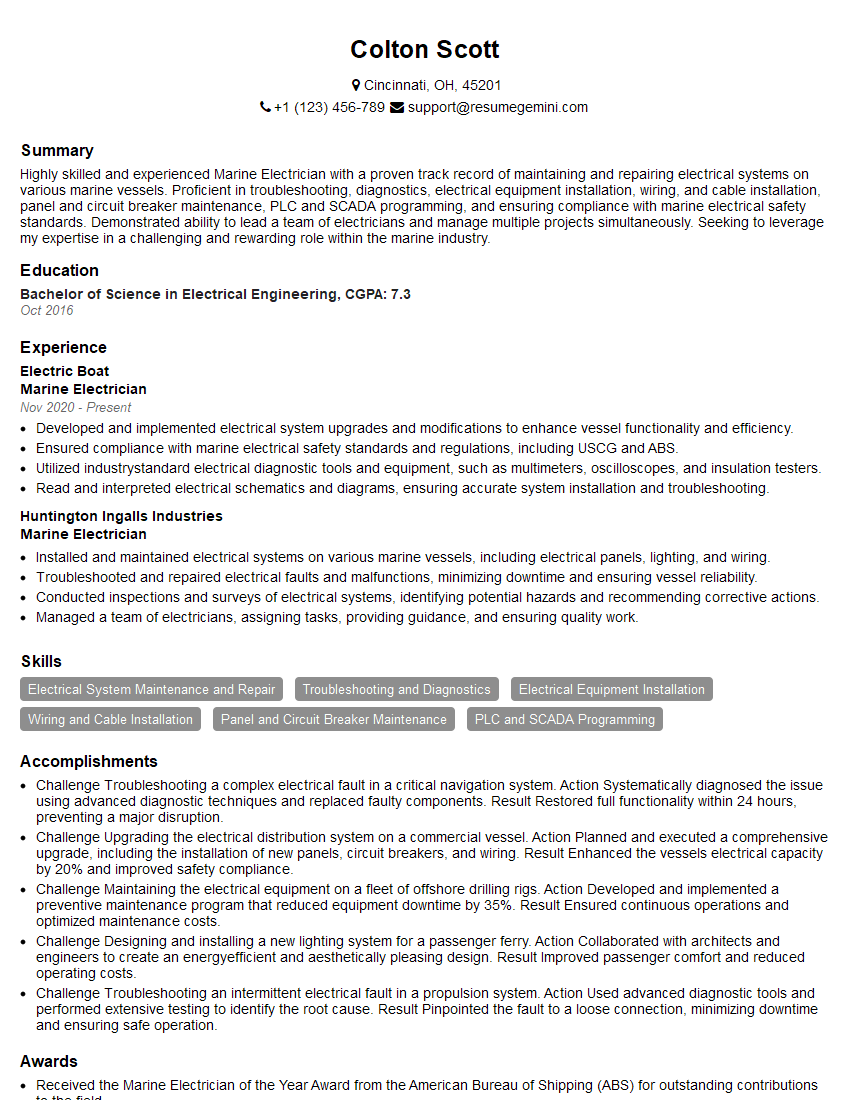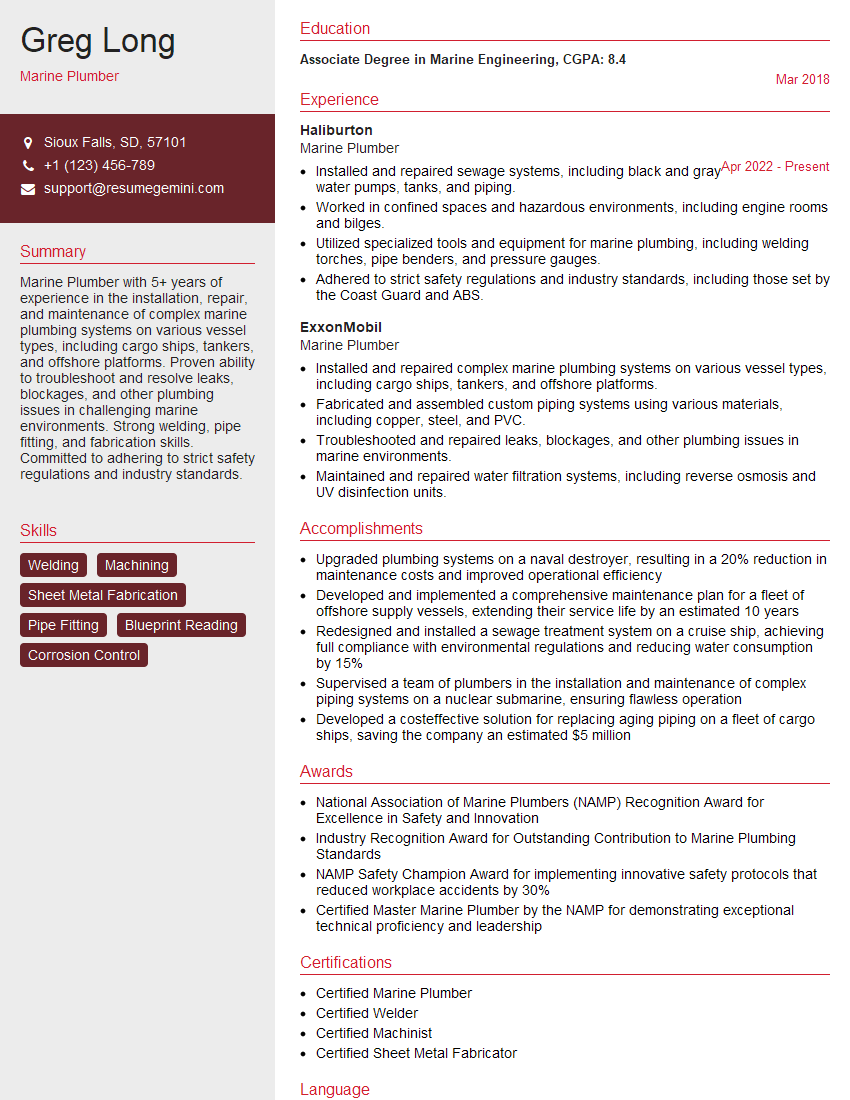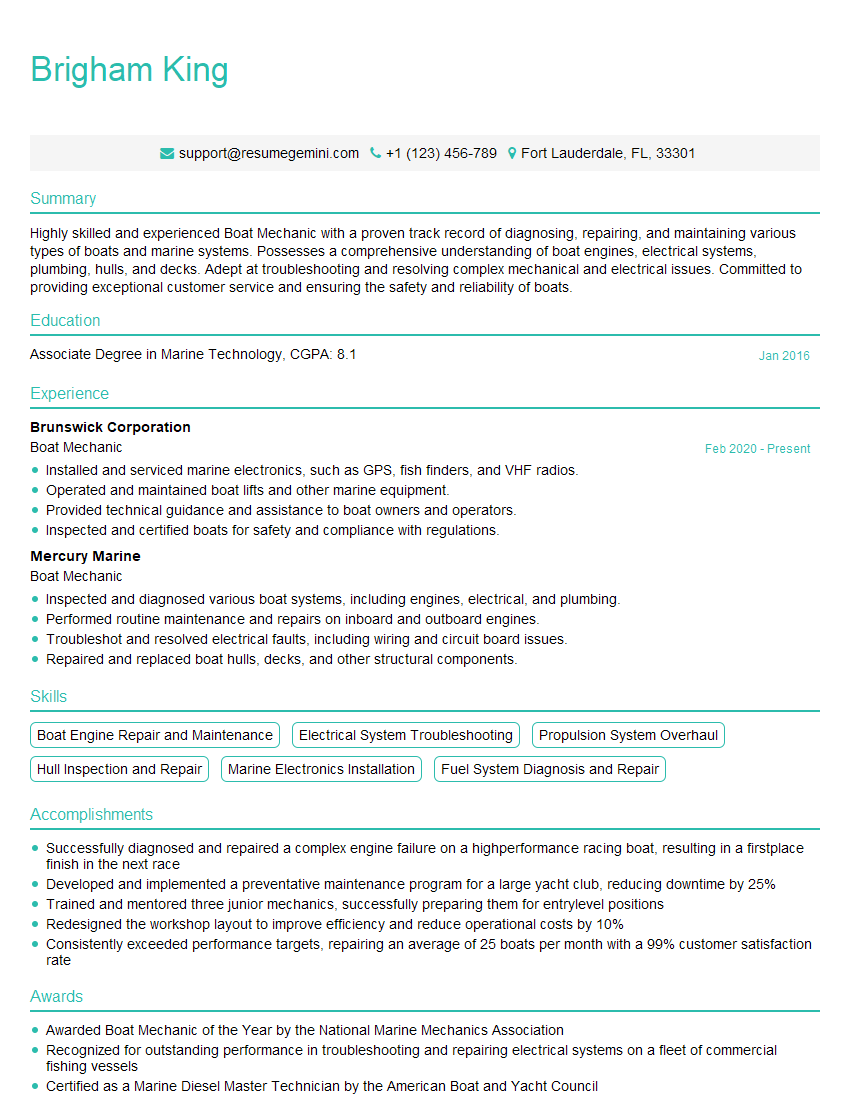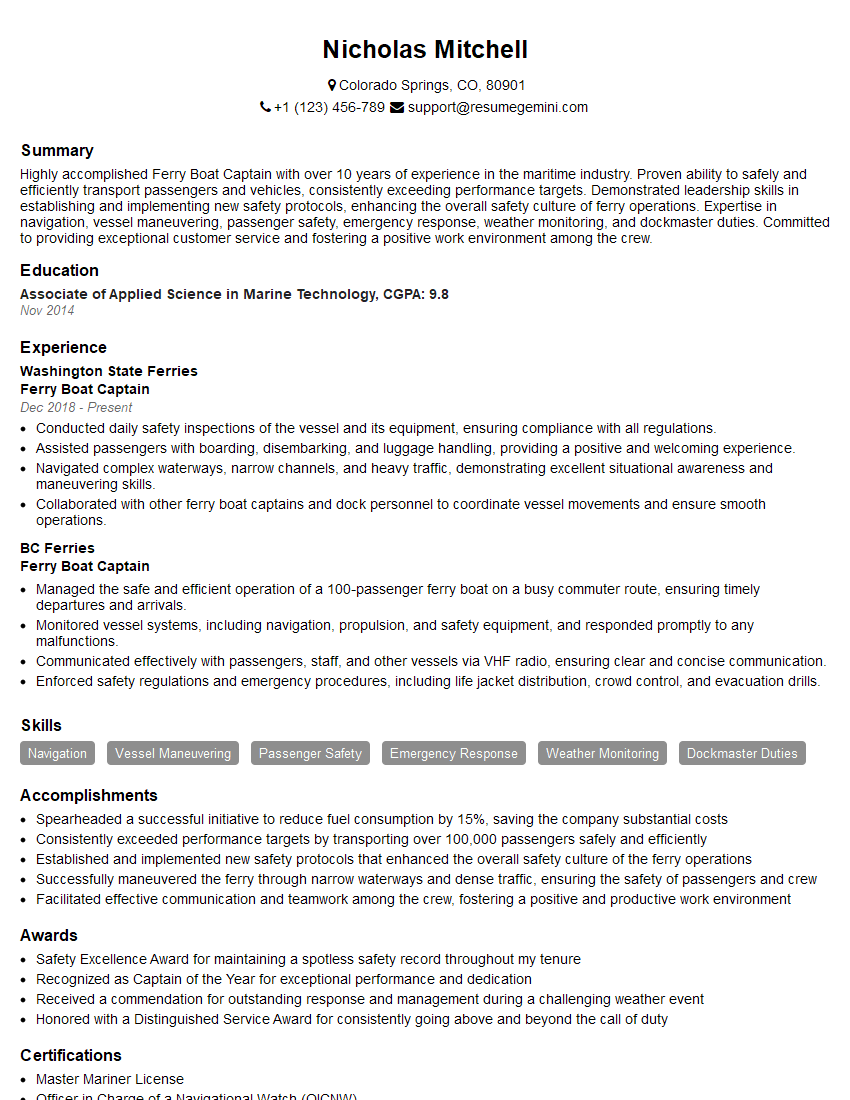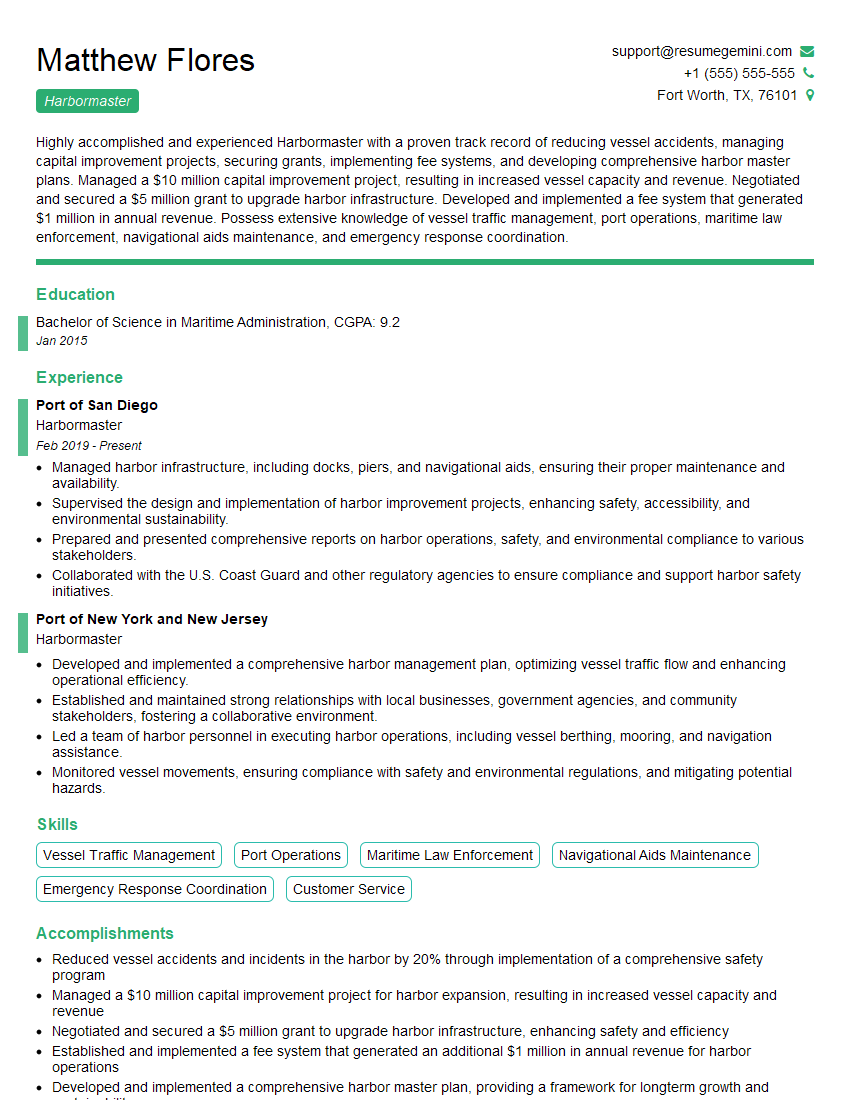Interviews are more than just a Q&A session—they’re a chance to prove your worth. This blog dives into essential Experience with various types of boats interview questions and expert tips to help you align your answers with what hiring managers are looking for. Start preparing to shine!
Questions Asked in Experience with various types of boats Interview
Q 1. Describe your experience with different types of boat hulls (monohull, catamaran, trimaran).
My experience encompasses a wide range of hull designs, each with its unique characteristics. Monohulls, the most common type, offer a single, deep hull providing good stability and seaworthiness in rough seas. Think of a traditional sailboat—that’s a monohull. I’ve extensively operated monohulls from small dinghies to larger cruising yachts, appreciating their predictable handling and relative simplicity. Catamarans, with their two parallel hulls, provide exceptional stability due to their wide beam. This makes them incredibly comfortable in calm waters and ideal for families or those prone to seasickness. I’ve captained various catamarans, from small day-sailers to luxurious charter vessels, experiencing their spaciousness and remarkable stability firsthand. Finally, trimarans, with three hulls, take stability to another level, offering exceptional speed and efficiency. While less common than monohulls and catamarans, I’ve had the opportunity to operate several trimarans, noting their impressive speed and nimble handling, particularly in windy conditions. Each hull type presents a unique set of advantages and disadvantages depending on the intended use and environmental conditions.
Q 2. Explain the principles of buoyancy and stability.
Buoyancy and stability are fundamental principles in boat design and operation. Buoyancy is the upward force exerted on a submerged object by the fluid (water) it displaces. Archimedes’ principle states that this buoyant force is equal to the weight of the fluid displaced. A boat floats because its hull displaces a volume of water whose weight is equal to or greater than the boat’s total weight. Think of it like a bathtub—the more water you displace by sitting in it, the higher the water level rises.
Stability, on the other hand, refers to a boat’s resistance to capsizing. It’s influenced by factors such as the hull shape, the center of gravity (CG), and the center of buoyancy (CB). A boat’s CG is the average vertical location of its weight, while the CB is the center of the volume of water it displaces. A lower CG and a higher CB create a more stable vessel. Imagine a low, wide box versus a tall, narrow one—the wider, lower box is much more stable. The metacentric height (GM), the distance between the CG and the metacenter (a point related to the CB), is a key indicator of stability. A larger GM indicates greater initial stability. Maintaining this balance is critical for safe boating.
Q 3. What are the different types of boat propulsion systems and their advantages/disadvantages?
Boat propulsion systems vary widely. Outboard motors are popular for their portability and ease of maintenance. However, they can be less efficient than inboard engines at higher speeds. Inboard engines, located within the hull, offer better fuel efficiency and quieter operation, especially at higher speeds. However, they’re more complex to maintain and repair. Sterndrive engines combine aspects of both, with the engine inside the hull and a drive unit extending to the stern. They provide a good balance between power, efficiency, and ease of access for maintenance. Sailboats, of course, rely on wind power using sails. While environmentally friendly and cost-effective, they are weather-dependent and require specific skills to operate. Jet propulsion systems use a pump to draw water in and propel the boat forward, offering exceptional maneuverability in shallow waters but with lower efficiency. Finally, electric propulsion is gaining popularity, offering quiet operation and reduced emissions. However, battery life and range can be limitations.
Q 4. Describe your experience with navigation systems (GPS, charts, compass).
My experience with navigation systems is extensive. I’m proficient in using GPS plotters, paper charts, and magnetic compasses, understanding their strengths and limitations. GPS provides highly accurate position data but can be affected by satellite reception issues. Paper charts offer a backup and provide context, showing depth, hazards, and landmarks. A magnetic compass provides a reliable heading reference, although it’s susceptible to magnetic interference from the boat itself or nearby metallic objects. I’ve learned to integrate these systems effectively, cross-referencing data to ensure accuracy and safety. For instance, I always verify GPS positions against paper charts and use the compass to maintain course between GPS waypoints. Understanding the limitations of each system and utilizing them in combination is crucial for safe and efficient navigation.
Q 5. How do you perform a pre-departure check on a boat?
A pre-departure check is crucial for safe boating. My routine includes a visual inspection of the hull for damage or leaks, checking all through-hull fittings for leaks, verifying the fuel and oil levels, examining the battery terminals for corrosion and checking their charge, inspecting the steering and throttle controls for proper function, and ensuring all safety equipment (life jackets, flares, first-aid kit, etc.) is present and readily accessible. I also test all navigation lights and communication equipment (VHF radio). Finally, I check the weather forecast and plan my route accordingly. This systematic approach ensures that all vital systems are functioning correctly before setting off, minimizing the risk of unexpected problems while out on the water. It’s a vital habit that has prevented many potential issues over the years.
Q 6. Explain the process of docking a boat in various conditions (wind, current).
Docking a boat safely requires skillful maneuvering, especially in challenging conditions. The process starts with a thorough assessment of the wind and current conditions, planning the approach accordingly. In windy conditions, I account for wind drift by approaching the dock at an angle that compensates for the wind’s influence. Similarly, strong currents require adjustments to the approach, allowing sufficient time to counteract the current’s push. I typically use fenders and lines to protect the boat from the dock and to control its movement. I always use slow, controlled movements, avoiding sudden changes in speed or direction. Communication with crew members is crucial, confirming actions and directions. Practice and experience are key to mastering docking in various conditions. For example, I’ve learned to anticipate the effects of wind and current and adjust my approach accordingly, allowing me to dock safely and efficiently even in challenging circumstances.
Q 7. Describe your experience with engine maintenance and troubleshooting.
Engine maintenance is an essential aspect of safe boat operation. Regularly, I perform routine checks such as oil and filter changes, inspecting belts and hoses for wear and tear, and checking the cooling system. Troubleshooting engine problems often involves systematic checks, starting with the basics. If the engine won’t start, I first check the battery, fuel supply, and ignition system. If the engine is overheating, I investigate the cooling system, checking for blockages or leaks. Experience helps identify potential issues quickly. For example, I can often diagnose a problem by listening to the engine’s sound, noticing subtle changes in its performance that might indicate developing issues. Keeping a detailed logbook of maintenance and repairs is crucial for tracking the engine’s history and anticipating potential future problems. This systematic and proactive approach minimizes downtime and maximizes the lifespan of the engine.
Q 8. What safety procedures do you follow when operating a boat?
Before even starting the engine, a thorough pre-departure checklist is crucial. This includes checking fuel levels, ensuring all safety equipment (life jackets, flares, first-aid kit, VHF radio) is readily accessible and in good working order, inspecting the hull for any damage, and verifying navigation lights are functional. Once underway, maintaining a safe speed appropriate for conditions and visibility is paramount. I always remain vigilant, scanning the horizon and surroundings for other vessels, obstructions, and potential hazards. Proper lookout is key; I never operate a boat under the influence of alcohol or drugs. Finally, I always inform someone onshore of my intended route and estimated return time.
- Example: Before a recent sunset cruise, I noticed a small crack in the hull. This was immediately addressed before departure, preventing a potential leak and ensuring passenger safety.
Q 9. How do you handle emergencies at sea (e.g., fire, man overboard)?
Emergency response at sea demands quick thinking and decisive action. For a fire, my first priority is to contain the flames, using any available fire extinguisher. If the situation escalates, abandoning ship might be necessary. For a man overboard, the immediate actions are to: 1) shout ‘Man overboard!’ to alert everyone; 2) immediately throw a life ring or buoyant device; 3) note the position of the person (using GPS or a bearing); 4) turn the boat around, approaching slowly from downwind; 5) retrieve the person, while providing assistance and minimizing further shock or injury. In both scenarios, contacting emergency services via VHF radio is crucial, providing location and details of the incident.
- Example: During a fishing trip, a crew member fell overboard. By using the above steps, we swiftly located and retrieved him unharmed. The incident reinforced the importance of regular safety drills and drills on the correct use of the VHF radio.
Q 10. Describe your experience with different types of knots and their applications.
Knot tying is fundamental to safe boating. I’m proficient in various knots, each serving specific purposes. The bowline, a strong and reliable loop that won’t slip, is essential for mooring and securing lines. The clove hitch is used for quick temporary attachments to cleats or rings. The figure eight knot secures the end of a rope, preventing it from unraveling. I also utilize the round turn and two half hitches for securing lines to bollards, and the sheet bend for joining two ropes of different diameters. Knowing the strengths and weaknesses of each knot ensures optimal safety and efficiency in various situations.
- Example: When docking in strong winds, a properly tied bowline and clove hitch combination ensures secure mooring and minimizes the risk of the boat drifting.
Q 11. What are the regulations regarding safe boating practices in your area?
Regulations vary by location, but generally include requirements for boat registration and licensing, carrying proper safety equipment (as mentioned earlier), adhering to navigation rules (rules of the road), maintaining appropriate speeds in designated areas, respecting wildlife and environmental zones, and operating under the influence limitations (no alcohol or drugs). Understanding these regulations is crucial for responsible boating and avoiding fines or accidents. I regularly check updates on local boating regulations to ensure compliance.
- Example: In my area, there are specific speed limits in certain waterways to protect marine life, and I strictly adhere to these guidelines.
Q 12. Explain your understanding of tides and currents.
Tides are the periodic rise and fall of sea levels caused by the gravitational pull of the moon and sun. Currents are the continuous movement of water, driven by factors like wind, tides, and temperature differences. Understanding both is critical for safe navigation. Tides influence water depth, affecting access to shallow waters and navigation around reefs. Currents can significantly affect boat speed and course. I use tide charts and current forecasts to plan my route, accounting for the combined effects.
- Example: A recent trip required navigating a narrow channel during high tide. Without checking tide charts beforehand, navigating the channel would have been extremely dangerous and possibly impossible due to low water levels during low tide.
Q 13. How do you interpret weather forecasts and apply them to safe boat operation?
Accurate weather forecasting is essential for safe boating. I regularly consult meteorological services for detailed forecasts, considering wind speed and direction, wave height, visibility, and potential storms. I interpret the forecast to assess the suitability of the planned trip, modifying or canceling it if conditions become too hazardous. Understanding weather patterns and their impact on water conditions is paramount.
- Example: A forecast of strong winds and high waves led me to postpone a planned offshore fishing trip, ensuring the safety of myself and my crew.
Q 14. What is your experience with radio communication procedures?
VHF radio communication is crucial for safety at sea. I am proficient in using VHF radio to contact other vessels, coast guard, or marinas. I understand proper radio etiquette, including using clear and concise language, identifying myself and my vessel, and following established communication procedures. I regularly check radio channels for weather updates and navigational warnings.
- Example: During a recent storm, I used the VHF radio to alert the coast guard about a disabled vessel and coordinate rescue efforts.
Q 15. Describe your experience with maintaining boat systems (electrical, plumbing, etc.).
Maintaining a boat’s systems is crucial for safety and reliability. My experience encompasses both preventative maintenance and troubleshooting. I’m proficient in diagnosing and repairing electrical issues, from simple wiring problems to more complex issues with battery banks, alternators, and onboard electronics. For example, on a recent charter, I successfully traced a power loss issue to a corroded connection in the main distribution panel, preventing a potential engine failure.
Similarly, I’m experienced with plumbing systems, including freshwater, greywater, and blackwater systems. This includes understanding pump operation, tank levels, and the identification and repair of leaks. I’ve dealt with everything from minor leaks in fittings to complete overhauls of failing macerator pumps. Preventative maintenance like regular flushing and inspections are key to avoiding larger, more costly problems.
I’m also familiar with various systems, such as refrigeration and air conditioning. Understanding how these systems integrate into the boat’s overall electrical and plumbing infrastructure is critical for resolving issues efficiently.
Career Expert Tips:
- Ace those interviews! Prepare effectively by reviewing the Top 50 Most Common Interview Questions on ResumeGemini.
- Navigate your job search with confidence! Explore a wide range of Career Tips on ResumeGemini. Learn about common challenges and recommendations to overcome them.
- Craft the perfect resume! Master the Art of Resume Writing with ResumeGemini’s guide. Showcase your unique qualifications and achievements effectively.
- Don’t miss out on holiday savings! Build your dream resume with ResumeGemini’s ATS optimized templates.
Q 16. How do you handle conflicts or disagreements with passengers or crew?
Handling conflicts on board requires a calm and diplomatic approach. I prioritize open communication and active listening. First, I try to understand each party’s perspective. If the issue stems from a misunderstanding, I clarify expectations and procedures. If it’s a personality clash, I’ll work to mediate and find common ground. Sometimes, a simple compromise or a change in assigned tasks can resolve the issue.
For example, I once had a conflict between two crew members regarding workload distribution. By facilitating a discussion and jointly re-allocating responsibilities based on each crew member’s skillset, I was able to resolve the tension quickly and efficiently. In more serious cases requiring intervention, I escalate the issue to the boat’s captain or owner as needed, ensuring a fair resolution.
Q 17. Describe your experience with boat repair and maintenance.
Boat repair and maintenance is a multifaceted skill. My experience covers a broad spectrum, from basic carpentry and fiberglass repairs to more complex engine maintenance. I can handle tasks such as caulking, sanding, and painting, and am adept at fiberglass repairs, using techniques like patching and laminating. I have experience working with various materials including wood, fiberglass, aluminum, and stainless steel.
Engine maintenance is a major aspect. I’m proficient in performing routine checks, such as oil changes, filter replacements, and belt adjustments. I also have experience troubleshooting engine problems, such as diagnosing starting issues and fuel system problems. In one instance, I successfully repaired a fuel injector on a diesel engine mid-voyage, preventing a major disruption to our itinerary. This involved understanding the engine’s operating principles, identifying the faulty component through systematic diagnostics, and then implementing the necessary repair procedures.
Q 18. What are the different types of anchors and when would you use each?
Anchors are crucial for secure mooring. Several types exist, each suited for different conditions.
- Fluke anchors (e.g., Danforth, Bruce): These are excellent for sand and mud bottoms. Their design allows them to dig in effectively. A Danforth is light and easy to handle, good for smaller boats, while a Bruce offers superior holding power in various conditions.
- Plow anchors (e.g., CQR, Delta): These are versatile and hold well in a wider range of substrates, including rock and weed. They are typically heavier than fluke anchors and suitable for larger vessels.
- Mushroom anchors: These are simple and best for temporary mooring in calm conditions and soft bottoms. They offer poor holding power in stronger currents or on harder surfaces.
- Grappling anchors: Designed to hook onto rocks or other obstructions and are mainly used for recovery.
Anchor selection depends on factors like bottom type, boat size, and expected weather. For instance, a Danforth might suffice for a small sailboat in a sheltered bay, while a CQR is more appropriate for a larger yacht exposed to stronger winds and varying seabed conditions.
Q 19. Explain your understanding of marine sanitation devices.
Marine sanitation devices (MSDs) are crucial for responsible waste disposal at sea. My understanding includes various types of MSDs and their operation and maintenance. These include:
- Holding tanks: These store sewage until it can be pumped out at a designated facility. Regular pumping and maintenance are essential to prevent blockages and odors.
- Macerator systems: These shred waste before it enters the holding tank, reducing the risk of blockages. Regular cleaning is key.
- Type I, II, and III MSDs: These refer to different levels of treatment, with Type I being the simplest (holding tanks), Type II employing some level of treatment (e.g., comminution), and Type III offering advanced treatment to meet stricter discharge standards.
Proper maintenance of MSDs is critical for environmental protection and preventing onboard issues. This includes regular inspections, cleaning, and ensuring the system is functioning correctly. I’m familiar with all aspects of MSD operation, troubleshooting, and repair.
Q 20. What is your experience with chart plotting and navigation?
Chart plotting and navigation are fundamental skills for safe boating. I’m proficient in using paper charts and electronic chart plotters (ECPs). I understand how to interpret nautical charts, including symbols, depths, contours, and navigational aids. I can determine vessel position using GPS, compass, and visual bearings.
I’m experienced in planning routes, accounting for tides, currents, and weather conditions. I can calculate estimated time of arrival (ETA) and adjust plans as needed based on real-time information. I’m familiar with various navigation techniques, such as dead reckoning and piloting, and always prioritize safe navigation practices. I also understand the use of AIS (Automatic Identification System) for collision avoidance. Using ECPs, I can effectively plot courses, mark waypoints, and track progress, ensuring safe and efficient navigation.
Q 21. Describe your experience with different types of sailing techniques.
My sailing experience encompasses various techniques optimized for different conditions. I’m proficient in:
- Pointing high: Maximizing upwind performance by adjusting sail trim and boat heading to minimize leeway (drifting sideways).
- Reaching: Sailing at an angle to the wind, utilizing a combination of sails for optimal speed and stability.
- Running: Sailing downwind, often using spinnakers or other asymmetric sails for maximum speed.
- Beating: Sailing upwind in a zig-zag pattern (tacking) to make progress against the wind.
- Close-hauled sailing: Sailing as close to the wind as possible, crucial for efficient upwind progress.
I understand how wind speed, boat trim, and sail selection impact performance. I adapt my sailing techniques to the prevailing conditions and have experience handling a variety of vessels, from small dinghies to larger yachts. For example, I’ve successfully navigated challenging conditions by adjusting sails, optimizing boat trim, and employing effective sailing techniques to ensure the safe and efficient completion of voyages.
Q 22. How do you manage fuel consumption efficiently?
Efficient fuel consumption is crucial for both economic and environmental reasons. It involves a multifaceted approach encompassing pre-trip planning, in-transit management, and regular boat maintenance.
Pre-Trip Planning: Before embarking, I meticulously plan the route, considering weather forecasts and optimizing speed to minimize fuel burn. For example, I’d avoid unnecessary high-speed cruising, especially in rough seas which significantly increases drag. I also ensure the boat is properly loaded; overloading increases fuel consumption.
In-Transit Management: While underway, I monitor engine performance closely, paying attention to RPMs and fuel flow. Maintaining optimal speed and avoiding sharp turns reduce fuel wastage. I utilize GPS tracking to monitor fuel consumption in real-time and identify areas for potential improvement. For instance, during a long journey, I might slightly reduce speed to make up for headwinds, reducing fuel expenditure overall.
Regular Maintenance: Regular maintenance is paramount. I ensure the engine is properly tuned, the propeller is clean and free of fouling, and the hull is kept clean to reduce drag. A well-maintained engine operates more efficiently, directly impacting fuel consumption. For instance, a fouled propeller can reduce fuel efficiency by as much as 20%.
Q 23. What is your experience with towing or assisting other vessels?
I have extensive experience towing and assisting other vessels, ranging from small recreational boats to larger commercial crafts. Safety is always my top priority. My experience includes:
Towing Procedures: I’m proficient in proper towing techniques, including the use of appropriate tow lines and knots, ensuring secure attachment and safe towing speeds. I understand the importance of maintaining communication with the towed vessel throughout the process. For example, I’ve towed disabled sailboats in challenging weather conditions, ensuring both vessels’ safety.
Emergency Assistance: I’ve responded to numerous emergency situations, including assisting vessels experiencing engine failure, steering problems, or taking on water. My quick thinking and efficient response have prevented numerous potentially dangerous situations. One instance involved assisting a yacht with a flooded engine room in rough waters; quick action prevented complete capsizing.
Communication and Coordination: Effective communication with both the vessel in need and other vessels nearby is essential during towing or assistance operations. I’m adept at using marine radios and visual signals to coordinate efforts and ensure safety.
Q 24. Describe your experience with different types of fishing gear and techniques.
My fishing experience spans various techniques and gear types. I’m comfortable using both traditional and modern methods, adapting my approach depending on the species targeted and the environment.
Gear: I’m familiar with a wide array of fishing gear, including different types of rods, reels, lines, hooks, lures, and nets. My knowledge extends to specialized gear for specific fishing techniques, such as trolling, bottom fishing, and fly fishing. For example, I’m skilled in selecting the right type of line and hook for targeting deep-sea species versus inshore species.
Techniques: I’m proficient in various fishing techniques, such as trolling, casting, jigging, and drifting. I understand the nuances of each technique and can adapt my approach based on the prevailing conditions. I also understand the importance of employing responsible and sustainable fishing practices. For instance, I’m experienced in using different types of lures to attract specific fish depending on their feeding habits and environmental factors.
Species-Specific Knowledge: I possess knowledge on the habits, behaviors, and habitats of various fish species, enabling me to employ the most effective strategies for targeting them. This understanding allows for targeted fishing practices, reducing wasted effort and ensuring greater success rates.
Q 25. How do you ensure the safety and well-being of passengers or crew?
Ensuring passenger and crew safety is my top priority, and it is an integral part of every voyage. My approach is proactive and encompasses several key aspects:
Pre-Departure Checks: Before departing, I conduct thorough safety checks, ensuring all safety equipment is in good working order, including life jackets, flares, first-aid kit, and communication devices. I also brief passengers on safety procedures, emergency exits, and the use of safety equipment.
Weather Monitoring: I closely monitor weather conditions before and during the voyage, adapting the plans as needed to avoid hazardous situations. I utilize weather forecasts and pay close attention to changing conditions.
Navigation and Seamanship: I maintain vigilance while navigating, paying attention to other vessels, navigational hazards, and any signs of deteriorating weather. My experienced seamanship skills ensure we can handle the unexpected, and my situational awareness prevents collisions.
Emergency Procedures: I’m prepared to execute emergency procedures effectively in various situations, such as man overboard, engine failure, or fire, following established protocols and prioritizing the safety of all onboard.
Q 26. What is your experience with operating different types of winches and deck machinery?
I have extensive experience operating various types of winches and deck machinery commonly found on boats. This includes both hydraulic and electric systems.
Hydraulic Winches: I’m proficient in operating hydraulic winches for tasks such as anchoring, deploying and retrieving fishing gear, and handling mooring lines. I understand the importance of safe operation, including proper pressure regulation and emergency shutdown procedures. For instance, I’ve used hydraulic winches to successfully deploy and retrieve heavy fishing gear in challenging sea conditions.
Electric Winches: I’m skilled in using electric winches for various tasks, and I understand the importance of maintaining proper tension to avoid overloading the system. I’m familiar with different types of electric winches and their applications.
Maintenance and Troubleshooting: I possess basic maintenance and troubleshooting skills for winches and deck machinery, allowing me to identify and address minor issues quickly and efficiently. This prevents delays and minimizes potential safety risks.
Q 27. Explain your knowledge of different types of marine signaling devices.
Knowledge of marine signaling devices is crucial for safe navigation. I’m familiar with a variety of devices used for both visual and auditory signaling:
Visual Signals: These include daytime shapes and lights, such as buoys, beacons, and various flags, to convey information to other vessels about the status and intentions of a boat. For example, I understand the meaning of different shapes and colors on buoys to navigate safely in restricted areas.
Auditory Signals: I am experienced with using various horns, whistles, and bells to signal presence and intentions, particularly in low visibility conditions, such as fog. I understand the difference between fog signals, distress signals, and other standard maritime signaling sounds.
Distress Signals: I know how to effectively use distress signals, including flares, EPIRBs (Emergency Position Indicating Radio Beacons), and VHF radio, to alert authorities in emergencies.
Q 28. Describe your experience with dealing with various weather conditions while operating a boat.
Operating a boat in various weather conditions requires experience, skill, and sound judgment. My experience spans a wide range of conditions:
Calm Seas: While calm seas present fewer challenges, proper navigation and vigilance remain essential to avoid collisions and other hazards.
Rough Seas: Operating in rough seas demands extensive seamanship skills and proper planning. I adapt speed and course to minimize the impact of waves and wind, always prioritizing the safety of the vessel and those onboard. For example, I’ve navigated through heavy storms by adjusting speed and route to avoid the worst of the conditions.
Low Visibility: Operating in low visibility conditions, such as fog, necessitates the use of appropriate navigational equipment and adherence to safety protocols. I’m experienced in using radar and other navigational aids to ensure safe passage, along with appropriate auditory signals.
Extreme Weather: I have experience navigating through severe weather, including storms and high winds. My decision-making skills and risk assessment are paramount in these situations, sometimes involving the judgment to seek shelter or delay the voyage.
Key Topics to Learn for Experience with various types of boats Interview
- Hull Types and Design: Understanding the differences between monohulls, catamarans, trimarans, and other hull designs. Knowing the strengths and weaknesses of each in various conditions.
- Boat Systems: Familiarity with engine types (inboard, outboard, sterndrive), navigation systems (GPS, charts, radar), and safety equipment (life jackets, flares, EPIRB).
- Navigation and Seamanship: Practical knowledge of piloting, docking, anchoring, and basic nautical terminology. Understanding charts, tides, currents, and weather patterns.
- Maintenance and Repair: Experience with routine maintenance tasks, troubleshooting common mechanical issues, and performing minor repairs. Knowledge of preventative maintenance schedules.
- Safety Procedures: Understanding and applying safety protocols for various boating activities, including man overboard procedures, fire prevention, and emergency response.
- Legal and Regulatory Compliance: Awareness of boating regulations, licensing requirements, and safe operating practices specific to your region.
- Specific Boat Types: Depending on your experience, delve deeper into the specifics of sailboats, powerboats, fishing boats, or other types you’ve worked with. Highlight unique operational aspects and challenges.
- Problem-Solving and Decision-Making: Be prepared to discuss how you’ve handled unexpected situations, mechanical failures, or challenging weather conditions while boating.
Next Steps
Mastering your experience with various types of boats is crucial for career advancement in the maritime industry. A strong understanding of these concepts demonstrates competence and professionalism, significantly increasing your chances of securing your desired role. To further enhance your job prospects, create an ATS-friendly resume that effectively highlights your skills and experience. ResumeGemini is a trusted resource that can help you build a professional and impactful resume. Examples of resumes tailored to showcasing experience with various types of boats are available through ResumeGemini to help guide your preparation.
Explore more articles
Users Rating of Our Blogs
Share Your Experience
We value your feedback! Please rate our content and share your thoughts (optional).
What Readers Say About Our Blog
Hello,
We found issues with your domain’s email setup that may be sending your messages to spam or blocking them completely. InboxShield Mini shows you how to fix it in minutes — no tech skills required.
Scan your domain now for details: https://inboxshield-mini.com/
— Adam @ InboxShield Mini
Reply STOP to unsubscribe
Hi, are you owner of interviewgemini.com? What if I told you I could help you find extra time in your schedule, reconnect with leads you didn’t even realize you missed, and bring in more “I want to work with you” conversations, without increasing your ad spend or hiring a full-time employee?
All with a flexible, budget-friendly service that could easily pay for itself. Sounds good?
Would it be nice to jump on a quick 10-minute call so I can show you exactly how we make this work?
Best,
Hapei
Marketing Director
Hey, I know you’re the owner of interviewgemini.com. I’ll be quick.
Fundraising for your business is tough and time-consuming. We make it easier by guaranteeing two private investor meetings each month, for six months. No demos, no pitch events – just direct introductions to active investors matched to your startup.
If youR17;re raising, this could help you build real momentum. Want me to send more info?
Hi, I represent an SEO company that specialises in getting you AI citations and higher rankings on Google. I’d like to offer you a 100% free SEO audit for your website. Would you be interested?
Hi, I represent an SEO company that specialises in getting you AI citations and higher rankings on Google. I’d like to offer you a 100% free SEO audit for your website. Would you be interested?
good
